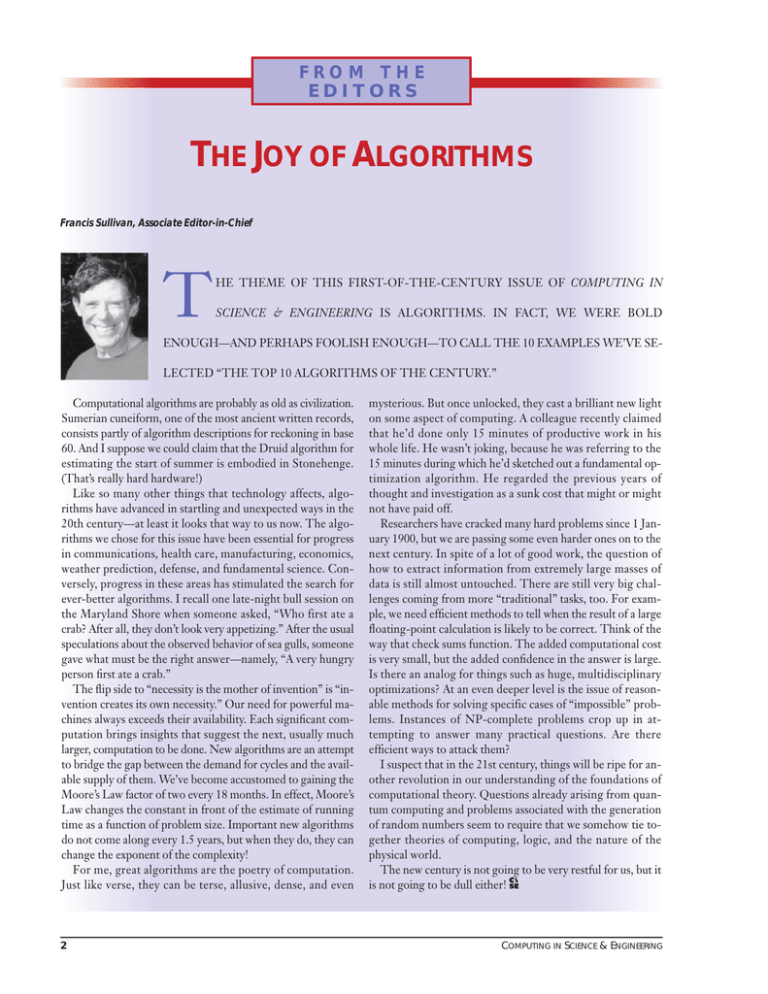T J A HE
advertisement

FROM THE EDITORS THE JOY OF ALGORITHMS Francis Sullivan, Associate Editor-in-Chief T HE THEME OF THIS FIRST-OF-THE-CENTURY ISSUE OF COMPUTING IN SCIENCE & ENGINEERING IS ALGORITHMS. IN FACT, WE WERE BOLD ENOUGH—AND PERHAPS FOOLISH ENOUGH—TO CALL THE 10 EXAMPLES WE’VE SELECTED “THE TOP 10 ALGORITHMS OF THE CENTURY.” Computational algorithms are probably as old as civilization. Sumerian cuneiform, one of the most ancient written records, consists partly of algorithm descriptions for reckoning in base 60. And I suppose we could claim that the Druid algorithm for estimating the start of summer is embodied in Stonehenge. (That’s really hard hardware!) Like so many other things that technology affects, algorithms have advanced in startling and unexpected ways in the 20th century—at least it looks that way to us now. The algorithms we chose for this issue have been essential for progress in communications, health care, manufacturing, economics, weather prediction, defense, and fundamental science. Conversely, progress in these areas has stimulated the search for ever-better algorithms. I recall one late-night bull session on the Maryland Shore when someone asked, “Who first ate a crab? After all, they don’t look very appetizing.’’ After the usual speculations about the observed behavior of sea gulls, someone gave what must be the right answer—namely, “A very hungry person first ate a crab.” The flip side to “necessity is the mother of invention’’ is “invention creates its own necessity.’’ Our need for powerful machines always exceeds their availability. Each significant computation brings insights that suggest the next, usually much larger, computation to be done. New algorithms are an attempt to bridge the gap between the demand for cycles and the available supply of them. We’ve become accustomed to gaining the Moore’s Law factor of two every 18 months. In effect, Moore’s Law changes the constant in front of the estimate of running time as a function of problem size. Important new algorithms do not come along every 1.5 years, but when they do, they can change the exponent of the complexity! For me, great algorithms are the poetry of computation. Just like verse, they can be terse, allusive, dense, and even 2 mysterious. But once unlocked, they cast a brilliant new light on some aspect of computing. A colleague recently claimed that he’d done only 15 minutes of productive work in his whole life. He wasn’t joking, because he was referring to the 15 minutes during which he’d sketched out a fundamental optimization algorithm. He regarded the previous years of thought and investigation as a sunk cost that might or might not have paid off. Researchers have cracked many hard problems since 1 January 1900, but we are passing some even harder ones on to the next century. In spite of a lot of good work, the question of how to extract information from extremely large masses of data is still almost untouched. There are still very big challenges coming from more “traditional” tasks, too. For example, we need efficient methods to tell when the result of a large floating-point calculation is likely to be correct. Think of the way that check sums function. The added computational cost is very small, but the added confidence in the answer is large. Is there an analog for things such as huge, multidisciplinary optimizations? At an even deeper level is the issue of reasonable methods for solving specific cases of “impossible’’ problems. Instances of NP-complete problems crop up in attempting to answer many practical questions. Are there efficient ways to attack them? I suspect that in the 21st century, things will be ripe for another revolution in our understanding of the foundations of computational theory. Questions already arising from quantum computing and problems associated with the generation of random numbers seem to require that we somehow tie together theories of computing, logic, and the nature of the physical world. The new century is not going to be very restful for us, but it is not going to be dull either! COMPUTING IN SCIENCE & ENGINEERING



